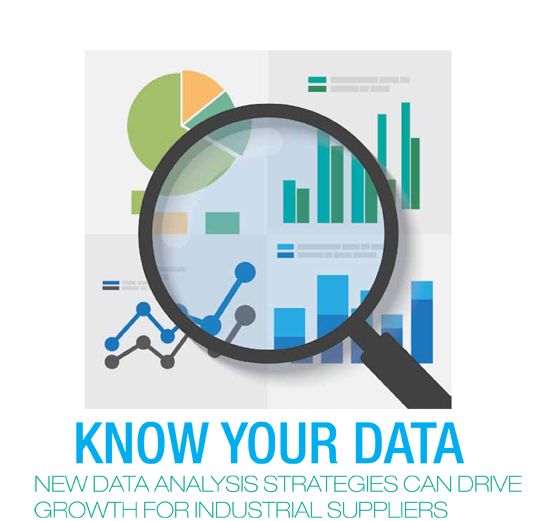Know Your Data

by Brent Halverson
Staying on top of relevant data trends can help businesses improve customer satisfaction while increasing operational efficiency and overall returns
Data analytics is old news. However, given the advancing technology and ever-changing customer needs, businesses need to stay up to date on data analysis to break away from old-school methods that no longer apply in the modern competitive landscape. B2B and B2C industries alike need to innovate and find new ways to effectively optimize their workflow and productivity in order to meet high customer standards such as the expectation of faster product deliveries.
A way to stay ahead is analysis of new data points. With vast quantities of information pouring in, identifying relevant data to track can be a daunting task. Key consideration points for data selection should be made according to visibility (or lack of) into customer satisfaction and business operations that profitability is hinged on. Data is useless without the right data sets and the ability to derive actionable insights from panoramic views of business operations. The right data can contribute to immediate operational decisions as well as help executive leadership to steer strategic long-term business planning.
Recent research by Transparency Market Research indicates the growth in industries of finance, manufacturing and distribution at a compound annual growth rate (CAGR) of 60.5 percent in the coming years. To keep up with this fast rate of growth, distribution and manufacturing companies are using meaningful data as a magnifying lens to analyze and evaluate metrics for success.
Data analysis takes the guesswork out of a company’s decision making, helping to predict success from operational business changes. Evaluating order data from an automated solution, for example, can help businesses identify key operational trends such as peak order periods, bottlenecks and error rates, as well as customer order preferences. These meaningful insights can be used not only to shed light on operational problems for companies to address proactively, but also help them uncover opportunities for improvement.
Knowing which data to track is crucial. There are some key strategies to consider when analyzing critical business data:
Order Volume and Preference by Day/Time
Understanding specific customer preferences and purchasing habits are essential to customer service and profitability. For example, tactics such as using order data to create customer profiles have dramatically improved marketing efforts and inventory control. Specifically, sales representatives can easily upsell or cross-sell, as well as forecast the amount of products each customer wants based on customer preference information. Additionally, identifying which products are in high demand and isolating peak periods of high/low shopper volume can produce significant benefits to sales and business operations. For instance, knowing a customer’s buying habits down to the exact time and day of purchases allows for integration with marketing strategy. Companies can time promotions and discounts accordingly to increase sales. Employee errors that stem from an overflow of demand are better targeted and proactively resolved, which in turn improves customer satisfaction.
Order Placement Channel
While general customer feedback and attention to buying patterns will allow for some insight into customer preferences, it is not enough to solely rely on this information in today’s competitive landscape. Digging into empirical data can allow businesses to view how customers are responding to sales on particular items, and which products sell better online versus through the phone, for example. While many expected e-commerce to take over as the preferred order channel, Modern Distribution Management’s 20161 study found that 74 percent of buyers very frequently or frequently order by email, in comparison to 60 percent via e-commerce and 58 percent by phone.
By evaluating the relevant data, companies are able to correctly pinpoint their most popular sales channel(s) by monitoring and analyzing orders from each simultaneously. This enables informed decision-making on staffing and technology improvements to boost efficiency, while providing insight into where to focus marketing efforts to optimize sales.
Time and Processing Costs of Order Cycles
Prior to automation technology, long order cycle times were the norm in sales transactions. Traditional order cycles took up to 27 days, with manual processing costs fluctuating between $30 and $60 per order.
Modern day innovation has opened many doors, making fast and accurate product delivery possible. Analyzing the timeframe a sales team takes to process eachbincoming purchase order and the associated costs can be valuable when allocating staff resources. These insights can also steer technology purchase decisions when evaluating sales order automation solutions. The data is also helpful for revealing bottlenecks and outlays that might thwart profitability and customer satisfaction.
By mapping the data and recognizing crucial patterns, businesses can take preventive measures to steer clear of potential pitfalls and reduce the time and costs spent on order processing.
Customer Satisfaction
Ultimately, the right strategies for analyzing data can lead to increased efficiency, ROI and customer retention. There are several different ways to evaluate customer satisfaction, but like with any data point, understanding how to transform insights into business decisions is the most valuable. Net Promoter Score (NPS) is a metric for assessing customer loyalty used to measure how many customers are recommending a given company or brand. If more customers promote a company than not, the score becomes positive. This generally means that the company is functioning at a high level of customer service. Monitoring NPS on a regular basis can alert businesses on operational changes and fluctuations that influence overall customer satisfaction.
Dissecting data while considering its relevance to operational profitability is critical for companies looking to increase customer satisfaction, reduce costs and maximize overall revenue. There is no doubt that understanding data remains the most powerful tool in driving businesses to success.
1“What Customers Want: A Distributor’s Guide to Customer Buying & Shopping Preferences (2016),” J. Bein & D. Mueller. © 2016 Gale Media Inc. All rights reserved.
 Brent Halverson is president and CEO of ecmarket, a cloud solutions developer of the patent-pending Conexiom sales order and invoice automation solution. Conexiom allows manufacturers and distributors to focus on serving customers and managing supplier relationships instead of entering data. For more information, visit conexiom.com.
Brent Halverson is president and CEO of ecmarket, a cloud solutions developer of the patent-pending Conexiom sales order and invoice automation solution. Conexiom allows manufacturers and distributors to focus on serving customers and managing supplier relationships instead of entering data. For more information, visit conexiom.com.
This article originally appeared in the July/August 2017 issue of Industrial Supply magazine. Copyright 2017, Direct Business Media.













